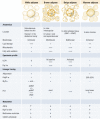Bone Marrow Adiposity: Basic and Clinical Implications
- PMID: 31127816
- PMCID: PMC6686755
- DOI: 10.1210/er.2018-00138
Bone Marrow Adiposity: Basic and Clinical Implications
Abstract
The presence of adipocytes in mammalian bone marrow (BM) has been recognized histologically for decades, yet, until recently, these cells have received little attention from the research community. Advancements in mouse transgenics and imaging methods, particularly in the last 10 years, have permitted more detailed examinations of marrow adipocytes than ever before and yielded data that show these cells are critical regulators of the BM microenvironment and whole-body metabolism. Indeed, marrow adipocytes are anatomically and functionally separate from brown, beige, and classic white adipocytes. Thus, areas of BM space populated by adipocytes can be considered distinct fat depots and are collectively referred to as marrow adipose tissue (MAT) in this review. In the proceeding text, we focus on the developmental origin and physiologic functions of MAT. We also discuss the signals that cause the accumulation and loss of marrow adipocytes and the ability of these cells to regulate other cell lineages in the BM. Last, we consider roles for MAT in human physiology and disease.
Copyright © 2019 Endocrine Society.
Figures




References
-
- Gregory CA, Prockop DJ, Spees JL. Non-hematopoietic bone marrow stem cells: molecular control of expansion and differentiation. Exp Cell Res. 2005;306(2):330–335. - PubMed
-
- Gimble JM, Robinson CE, Wu X, Kelly KA. The function of adipocytes in the bone marrow stroma: an update. Bone. 1996;19(5):421–428. - PubMed
-
- Cawthorn WP, Scheller EL, Learman BS, Parlee SD, Simon BR, Mori H, Ning X, Bree AJ, Schell B, Broome DT, Soliman SS, DelProposto JL, Lumeng CN, Mitra A, Pandit SV, Gallagher KA, Miller JD, Krishnan V, Hui SK, Bredella MA, Fazeli PK, Klibanski A, Horowitz MC, Rosen CJ, MacDougald OA. Bone marrow adipose tissue is an endocrine organ that contributes to increased circulating adiponectin during caloric restriction. Cell Metab. 2014;20(2):368–375. - PMC - PubMed

